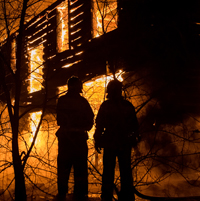Dangers of Plugging In: Electrical Fires Due to Overloaded Circuits
March 8, 2016 Chances are, you have probably “tripped” the circuit breaker in your home at one point or another. Whether it was a random occurrence or, perhaps, an indicator of potential electrical issues and problems, we feel it is important to discuss some electrical safety tips in regard to circuits and breakers as well as how to avoid overloading them.
Chances are, you have probably “tripped” the circuit breaker in your home at one point or another. Whether it was a random occurrence or, perhaps, an indicator of potential electrical issues and problems, we feel it is important to discuss some electrical safety tips in regard to circuits and breakers as well as how to avoid overloading them.
When forensic engineers trace the cause of a house fire after it occurs, more often than not, a fire shows itself to have originated in a room that is pushing out a lot of electricity. For example, this could be an entertainment or family room that has various entertainment items plugged in as well as lights, clocks, computers, etc.
However, there is no rule of thumb when it comes to “plugging in” and exactly how to go about it. For example, some house fires actually originate in a bedroom area, although typically, they are considered to be a space with fewer ignition sources than entertainment or kitchen areas. Bedrooms are usually viewed as “lower-risk” spaces due to the amount of electrical items powered inside of them – whereas a kitchen or family room is “higher-risk” because of increased electrical output.
Multi-outlet strips, or power strips can be especially risky. Many home electrical fires have been traced back to power strips, with a common post-fire discovery being multiple items plugged into one source. The multi-outlet strip can essentially create a fire when it must provide too much electricity and for too many items. These power strips are often on floors, in closets or under furniture, so should there be an electrical spark the chances of nearby items such as upholstery, clothing, bedding, etc. is much higher because of proximity and flammability.
Electrical fires can have more than one point of origin. While an overloaded multi-outlet strip may be one origin-point, secondary points of origin are common in home electrical fires as well. Typically, if there are two points of origin (or potentially more), electrical engineers will find that both points were on the same branch circuit, thus explaining the hazard. In other words, both electrical outlet sources would be receiving electricity from the same circuit. Overloaded electrical circuits are dangerous because they can only maintain a certain level of electrical output, and when they are so severely “over-plugged” their conductors overheat.
The consequences of residential fire can be severe and life altering, with losses ranging from personal to material. Professionals in the field, electrical engineers as well as forensic engineers, recommend keeping multi-outlet or power strips at their recommended electrical capacity as well as maintaining a clear, object-free space around all plugs and outlets to limit the risk of increased fire hazard.
Philadelphia Personal Injury Lawyers at Galfand Berger, LLP Represent Those Injured in Electrical Fires
The Philadelphia personal injury lawyers at Galfand Berger have successfully represented clients who were injured in their homes. If you or any of your loved ones have experienced such a situation, an attorney at Galfand Berger, LLP can help. With offices located in Philadelphia, Reading and Bethlehem, we serve clients throughout Pennsylvania and New Jersey. To schedule a consultation, call us at 800-222-8792 or complete our online contact form.
 Google Screened
Google Screened
